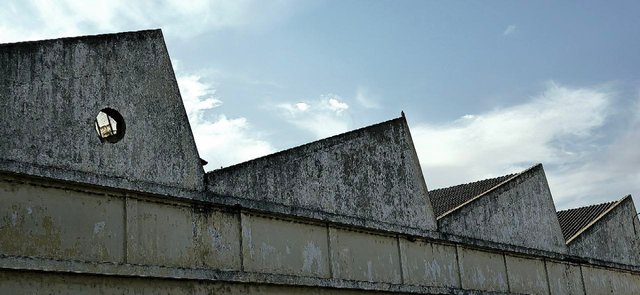The Enthusiasm That Leads to Decay: An Analysis of a Photograph
Hey everyone! It’s been a long, wonderful week around here, and there are always a ton of beautiful images waiting to be captured by the camera. The photo I managed to take this week that struck me the most is the one I'm sharing below. Though it might seem simple and mundane, I believe it holds a significant story worth telling.

Technical Description of the Image
Photographic Specifications:
- Resolution: 16329x7532, 123MP
- ISO: 12
- Focal Length: 23mm
- Exposure: 0.0ev
- Aperture: F1.7
- Shutter Speed: 1/833 s
Composition:
The image shows a section of an abandoned industrial building with sloping roofs and weather-beaten walls. The facade is stained and damaged, suggesting a long period of neglect. The sky above the building features light, drifting clouds, contrasting with the building's static decay.
Light and Color:
Natural light illuminates the building evenly, with no harsh shadows, suggesting a daytime atmosphere. The dominant color is a dull gray, both in the building's concrete and the partially overcast sky. This use of color contributes to a sense of desolation and abandonment.
Depth of Field:
The depth of field is broad, keeping both the building facade and the sky in focus. This choice emphasizes the structure of the building and its deterioration, while the open sky above adds a sense of vastness and isolation.
Content and Meaning
Mental State: Decay, Past Enthusiasm, and Consequences of Industrialization
The image effectively represents decay and serves as a critical reflection on the industrial past. The building, once a symbol of progress and modernity, now lies in ruins, evoking feelings of abandonment and obsolescence. Once magnificent and gleaming, a symbol of a bright future, it is now a relic of a bygone era.
Decay:
The dilapidated condition of the building suggests a slow but inevitable decline. The stained walls and crumbling concrete are visual metaphors for the physical and symbolic deterioration of industries that once thrived but have now fallen into disuse. This state of abandonment can be linked to Martin Heidegger's theory in Being and Time, where the passage of time brings inevitable decay and transience. The image visually represents Heidegger's ideas on transience and decline. The building, once a symbol of progress and activity, now lies in ruins, testifying to the passage of time and the inevitability of decline. This reflects the ephemeral nature of human constructions and civilizations, a theme Heidegger explores in the context of human existence and its temporality.
The abandoned building is a metaphor for Heidegger's concept of "Sein-zum-Tode" (Being-toward-death), showing how human creations, despite their potential and grandeur, are destined to age and disintegrate. This process of decay represents the temporal condition of existence, where every phase of construction and flourishing is inevitably followed by a phase of decline. Heidegger sees decay not only as a physical process but also as an existential condition. The decay of industrial buildings reflects the decay of the enthusiasm and hopes that built them. Modernity, with its promises of endless progress, is subject to the same laws of temporality and change.
In Being and Time, Heidegger discusses the concept of "care" (Sorge), describing how humans concern themselves with their being and future. Industrial decay can be seen as a physical manifestation of this care, a tangible reminder of temporal limitations and the consequences of our collective actions.
Enthusiasm for Past Industrialization:
The building represents the enthusiasm and hope that accompanied the industrial revolution. The construction of large factories and industrial plants promised progress, jobs, and innovation. However, over time, many of these symbols of progress have turned into relics of the past, reflecting a failure to sustain the initial progress. Karl Marx discussed the idea that industrialization, while initially bringing economic prosperity, also leads to alienation and dehumanization of workers, a theme echoed in the building's decay.
Negative Consequences:
The image also highlights the negative effects of industrialization. The ruined walls can symbolize the environmental and social impact of industries. Pollution, resource depletion, and the abandonment of industrial areas are all tangible consequences of rapid industrial development. Zygmunt Bauman, with his concept of "liquid modernity," explores how the solid structures of modernity, like factories, quickly become obsolete in a constantly changing world, leaving behind visible signs of decay and desolation.
Summary of Philosophical Reflection
Heidegger:
Heidegger's idea of "decay" and "being-toward-death" can be applied to the image. The abandoned industrial building represents a moment of reflection on human existence and the passage of time. The structure itself, once a symbol of life and activity, now lies inert, suggesting a meditation on mortality and the ephemeral nature of human achievements.
Marx:
Marx criticized industrialization for its dehumanizing and alienating effects. The image of the abandoned building can be seen as a symbol of the unfulfilled promise of industrial capitalism. The building's decay represents the disillusionment and alienation of the workers who contributed to its construction and operation, only to see their labor and sacrifices become obsolete.
Bauman:
Bauman explored how the solid structures of modernity quickly become liquid and unstable. The abandoned building is an example of how the physical constructions of modernity fail to maintain their relevance over time. Bauman's "liquid modernity" is reflected in the transition from enthusiasm for industrialization to a reality of abandonment and decay.
Conclusion
This image is a powerful visual representation of the mental state of decay, a reflection on past enthusiasm for industrialization, and a consideration of its negative consequences. The decay of the abandoned industrial building invites a meditation on time, progress, and the unfulfilled promises of modernity. The philosophical theories of Heidegger, Marx, and Bauman enrich this analysis, providing a deeper understanding of the image's meaning and implications. The image offers us a mirror in which we can see our collective history and current mental states reflected. It represents the transience and fragility of human creations, inviting us to a profound reflection on how progress and decay are intrinsically linked.